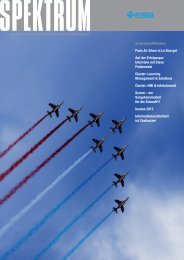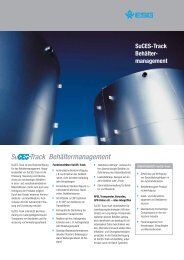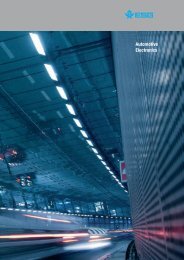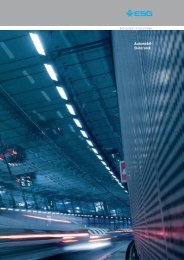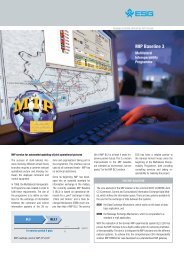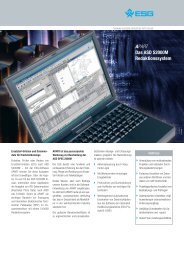C2 & Weapon Deployment System ADLER II - ESG
C2 & Weapon Deployment System ADLER II - ESG
C2 & Weapon Deployment System ADLER II - ESG
Create successful ePaper yourself
Turn your PDF publications into a flip-book with our unique Google optimized e-Paper software.
The Challenge<br />
Future missions for the German<br />
armed forces will primarily be carried<br />
out within the framework of combined<br />
and joint task forces. To successfully<br />
execute such operations, adequate<br />
command and control means are<br />
required. High-performance information<br />
and communication systems as a<br />
basis for network-enabled capabilities<br />
play an important role.<br />
A military commander needs a deployment<br />
support system which can<br />
quickly collect the huge amount of<br />
data from highly modern sensors and<br />
present the information in near realtime<br />
as a comprehensive operational<br />
picture. This system is required to<br />
support the process of situation-oriented<br />
decision-making on the basis<br />
of this highly detailed operational<br />
picture in conjunction with additional<br />
command and control information.<br />
If necessary, this can include the<br />
optimised and timely deployment of<br />
individual weapon platforms or combinations<br />
of different types of weapon<br />
systems.<br />
The <strong>ESG</strong> Solution<br />
<strong>ADLER</strong> <strong>II</strong> has been developed to meet<br />
this specific user profile.<br />
The command, control and weapon<br />
deployment system <strong>ADLER</strong> connects<br />
the network of STAR, command and<br />
control and effects systems of all the<br />
artillery forces in different formations<br />
under a uniform command.<br />
<strong>ADLER</strong> <strong>II</strong> is optimised for mobile<br />
deployment and ensures near realtime<br />
information exchange on the<br />
battlefield via digital radio within a<br />
communication network which automatically<br />
and continuously adapts to<br />
the situation. Up-to-date information<br />
on enemy and friendly forces is presented<br />
to the commander in an automatically<br />
updated, appropriately detailed<br />
and comprehensive situational<br />
picture. A flexible user role concept<br />
allows function-oriented control of the<br />
information flow and display of the information<br />
on a modern graphical user<br />
interface using a digital map.<br />
<strong>ADLER</strong> <strong>II</strong> supports the user with extensive<br />
functionality in the evaluation<br />
and prioritisation of the information<br />
and in the decision-making process,<br />
thus releasing him from routine tasks.<br />
Orders and missions can be initiated<br />
and their execution observed directly<br />
from the situation map. Analysis functions<br />
help to optimise the deployment<br />
of weapon systems, from individual<br />
weapon platforms including ballistics<br />
calculations through to the interaction<br />
of different weapon systems.<br />
<strong>ADLER</strong> <strong>II</strong> enables, by means of automated<br />
interfaces, multinational cooperation<br />
with the command, control<br />
and weapon deployment systems of<br />
other nations within the ASCA Programme<br />
(Artillery <strong>System</strong>s Cooperation<br />
Activities) and also in future joint<br />
cooperation with the Navy and Airforce<br />
in the area of Joint Fire Support.<br />
<strong>ADLER</strong> <strong>II</strong> can be configured by the<br />
user in accordance with his mission<br />
and can therefore be applied at<br />
all command levels. The concept of<br />
alternating command post configurations<br />
enables command posts to be<br />
assembled with varying numbers of<br />
<strong>C2</strong> & <strong>Weapon</strong><br />
<strong>Deployment</strong><br />
<strong>System</strong><br />
<strong>ADLER</strong> <strong>II</strong><br />
workstations, from an individual vehicle<br />
up to an operation centre with<br />
multiple shelters and dismounted<br />
workstations in fixed facilities.<br />
<strong>ADLER</strong> <strong>II</strong> combines the experience of<br />
over 10 years use in the German Artillery<br />
with modern information technology<br />
and user interfaces. <strong>ADLER</strong> <strong>II</strong> is<br />
open for upgrading and adaptation to<br />
the rapid progress of information technologies<br />
and the changing mission<br />
spectrum and organisational structure<br />
of the German Armed Forces.<br />
<strong>ESG</strong>, as the main contractor for the<br />
command, control and weapon deployment<br />
system <strong>ADLER</strong> <strong>II</strong>, has not<br />
only developed the system but has<br />
also supported and accompanied<br />
it during the fielding and in-service<br />
phases.<br />
The experience gained and the technologies<br />
applied in <strong>ADLER</strong> <strong>II</strong> also form<br />
the basis for DVA <strong>II</strong>, the command,<br />
control and weapon deployment system<br />
for mortar units, and for ARES <strong>II</strong>,<br />
the fire control system of the rocket<br />
artillery units.
User Interface<br />
Graphical user interface with digital<br />
map and situation display<br />
Scaleable according to the userspecific<br />
tasks<br />
Task-independent screen formats<br />
with user support and plausibility<br />
checks<br />
Context-sensitive help system<br />
Open Office applications<br />
Communication and<br />
Message handling<br />
Flexible addressing and network<br />
management with access control<br />
Comprehensive lists for receipt and<br />
transmission management<br />
Automated processing of all orders,<br />
messages and status information<br />
Information distribution scaleable in<br />
accordance with the specific task<br />
per workstation<br />
<strong>ADLER</strong> <strong>II</strong>, the key element in the artillery system network<br />
High performance database with<br />
back-up and command post interchange<br />
functions<br />
Surveillance, Target Acquisition<br />
and Reconnaissance<br />
Coordination and control of all<br />
target acquisition means<br />
Evaluation of target information by<br />
means of adjustable filter functions<br />
Comprehensive display in tables<br />
and on the map<br />
Tactical Fire Control<br />
Prioritisation of targets in accordance<br />
with flexible criteria<br />
Calculation of the optimal deployment<br />
of weapon systems and<br />
ammunition for fire mission<br />
proposals<br />
Optimisation of weapon and<br />
ammunition deployment with<br />
regard to time<br />
Checks of fire coordination and<br />
safety measures<br />
PERFoRMAnCE ChARACTERISTICS<br />
Automated or manual creation of<br />
fire missions and fire orders<br />
Detailed control of fire mission<br />
proposals<br />
Technical Fire Control<br />
Establishment and control of the<br />
readiness for action of fire units<br />
Ballistics calculations using the<br />
NABK (NATO Armaments Ballistic<br />
Kernel)<br />
Transformation of fire orders into<br />
gun commands<br />
Execution and status control of<br />
various firing procedures<br />
Map and Situation Display<br />
Digital map with various data<br />
formats (raster, vector, altitude,<br />
aerial picture)<br />
Self-updating, near real-time operational<br />
picture with variable filter and<br />
display options<br />
Graphical support for generating<br />
reports and orders from the digital<br />
map<br />
Interfaces<br />
Automatic interfaces to numerous<br />
national and international systems<br />
Standardised interfaces for interconnection<br />
with further systems<br />
or components<br />
TEChnICAL ChARACTERISTICS<br />
Operates on standard<br />
hardware with Intel architecture<br />
and Windows operating<br />
systems (2000, XP, Vista)<br />
Modern, modular componentbased<br />
software architecture<br />
with growth potential<br />
Scaleable hardware architecture<br />
ranging from a standalone<br />
workstation to major<br />
command posts with a<br />
number of workstations and<br />
shelters<br />
Use in stationary and mobile<br />
operation<br />
Identical hardware and<br />
software for all user roles and<br />
command levels<br />
Can be set up in accordance<br />
with the user’s role without<br />
additional system administration<br />
effort<br />
Communication protocols<br />
optimised for near real-time,<br />
secure and priority-dependent<br />
data transmission via digital<br />
radio (data, text, images)<br />
Various communication<br />
means (VHF, HF, LAN, WLAN,<br />
trunk networks)<br />
High speed command post<br />
communication via Ethernet<br />
for data and Voice over IP<br />
Turning system expertise into value4<strong>ESG</strong> Elektroniksystem- und Logistik-GmbH4Phone +49 (89) 92 16 - 04itk@esg.eu4www.esg.eu



